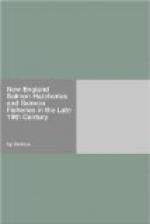My colleague, Everett Smith, of Portland, a civil engineer, while making a survey for a fishway, counted 15 salmon jumping in 30 minutes. A Mr. Bailey, who is foreman of the repair shop at Mattawamkeag walked up to the falls some three weeks since entirely out of curiosity excited by the rumors of the sight, and counted 60 salmon jumping in about an hour, within half or three-quarters of a mile of the falls. This is on the Mattawamkeag, which is a great tributary of the Penobscot.
On the east branch of the Penobscot there has been a great run of salmon. An explorer on the Wassattaquoik reported the pools literally black with salmon. A party of poachers, hearing the rumor, went in from the town of Hodgon and killed 25. I inclose you a letter to me from Mr. Prentiss, one of our most wealthy and prominent merchants, which speaks for itself: I will be obliged to you if you will return this, as I shall have occasion to use it in my report.
On the West branch of the Penobscot I hear reports of large numbers of salmon, but the breaking of the two great dams at Chesancook and the North Twin Dam, which holds back the great magazine of water of the great tributary lakes which feed the Penobscot, which is used to drive the logs cut in the winter, through the summer’s drought, has let up all the fish which hitherto were held back until the opening of the gates to let the logs through. These fish would not, of course, be seen, as they would silently make their way up.
I regret that I have nothing of more value to give you. Hoping that this small contribution may at least cheer you as it has me,
I remain, truly, yours,
E. M. Stilwell, Commissioner of Fisheries for State of Maine.
* * * * * *
Prof. Spencer F. Baird,
United States Commissioner Fish and Fisheries.
Bangor, October 3, 1879.
M. Stilwell, Esq.,
Dear sir: Prof. C. E. Hamlin of Harvard, and I made a trip to Mount Katahdin last month for scientific examination and survey of the mountain. I had been salmon fishing in July on the Grand Bonaventure, on Bay of Chaleur, and I could not see why we could not catch salmon on the east branch of the Penobscot at the Hunt place where we crossed it on our way in to Katahdin. I thought the pool from mouth of Wassatiquoik to the Hunt place, about a half-mile, must be an excellent salmon pool, and my guide and the people there confirmed this opinion. They said over a hundred salmon had been taken in that one pool this season. The nearest settlement, and only one on the whole east branch, is about six miles out from there, and the young men go on Sundays and fish with drift-nets. No regular fishing for market—only a backwoods local supply can be used. These fish were about of one size—say 8 to 11 pounds.




